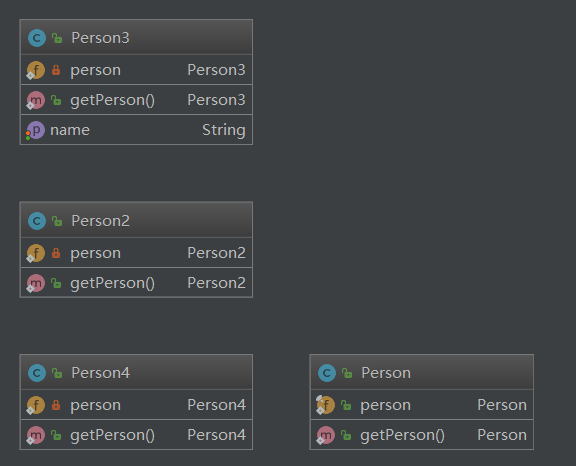单例模式
定义
单例模式是一种对象创建型模式,使用单例模式,可以保证为一个类只生成唯一的实例对象。也就是说,在整个程序空间中,该类只存在一个实例对象。
其实,GoF对单例模式的定义是:保证一个类、只有一个实例存在,同时提供能对该实例加以访问的全局访问方法。
场景
在应用系统开发中,我们常常有以下需求:
在多个线程之间,比如 servlet 环境,共享同一个资源或者操作同一个对象
在整个程序空间使用全局变量,共享资源
大规模系统中,为了性能的考虑,需要节省对象的创建时间等等。
因为Singleton模式可以保证为一个类只生成唯一的实例
对象,所以这些情况,Singleton模式就派上用场了。
实现
饿汉式。
懒汉式。
双重检查。
java
package com.darian.pattern_23._05_singleton;
public class Person {
public static final Person person = new Person();
//构造函数私有化
private Person() {
}
//提供一个全局的静态方法
public static Person getPerson() {
return person;
}
}package com.darian.pattern_23._05_singleton;
public class Person {
public static final Person person = new Person();
//构造函数私有化
private Person() {
}
//提供一个全局的静态方法
public static Person getPerson() {
return person;
}
}1
2
3
4
5
6
7
8
9
10
11
12
13
14
2
3
4
5
6
7
8
9
10
11
12
13
14
java
package com.darian.pattern_23._05_singleton;
public class Person2 {
private static Person2 person;
//构造函数私有化
private Person2() {
}
//提供一个全局的静态方法
public static Person2 getPerson() {
if(person == null) {
person = new Person2();
}
return person;
}
}package com.darian.pattern_23._05_singleton;
public class Person2 {
private static Person2 person;
//构造函数私有化
private Person2() {
}
//提供一个全局的静态方法
public static Person2 getPerson() {
if(person == null) {
person = new Person2();
}
return person;
}
}1
2
3
4
5
6
7
8
9
10
11
12
13
14
15
16
17
2
3
4
5
6
7
8
9
10
11
12
13
14
15
16
17
java
package com.darian.pattern_23._05_singleton;
public class Person3 {
private String name;
private static Person3 person;
public String getName() {
return name;
}
public void setName(String name) {
this.name = name;
}
//构造函数私有化
private Person3() {
}
//提供一个全局的静态方法,使用同步方法
public static synchronized Person3 getPerson() {
if(person == null) {
person = new Person3();
}
return person;
}
}package com.darian.pattern_23._05_singleton;
public class Person3 {
private String name;
private static Person3 person;
public String getName() {
return name;
}
public void setName(String name) {
this.name = name;
}
//构造函数私有化
private Person3() {
}
//提供一个全局的静态方法,使用同步方法
public static synchronized Person3 getPerson() {
if(person == null) {
person = new Person3();
}
return person;
}
}1
2
3
4
5
6
7
8
9
10
11
12
13
14
15
16
17
18
19
20
21
22
23
24
25
26
2
3
4
5
6
7
8
9
10
11
12
13
14
15
16
17
18
19
20
21
22
23
24
25
26
java
package com.darian.pattern_23._05_singleton;
public class Person4 {
private static Person4 person;
//构造函数私有化
private Person4() {
}
//提供一个全局的静态方法
public static Person4 getPerson() {
if(person == null) {
synchronized (Person4.class) {
if(person == null) {
person = new Person4();
}
}
}
return person;
}
}package com.darian.pattern_23._05_singleton;
public class Person4 {
private static Person4 person;
//构造函数私有化
private Person4() {
}
//提供一个全局的静态方法
public static Person4 getPerson() {
if(person == null) {
synchronized (Person4.class) {
if(person == null) {
person = new Person4();
}
}
}
return person;
}
}1
2
3
4
5
6
7
8
9
10
11
12
13
14
15
16
17
18
19
20
21
2
3
4
5
6
7
8
9
10
11
12
13
14
15
16
17
18
19
20
21
架构图

